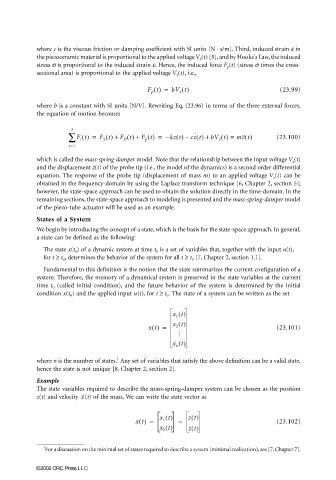Page 735 - The Mechatronics Handbook
P. 735
0066_Frame_C23 Page 43 Friday, January 18, 2002 5:31 PM
.
where c is the viscous friction or damping coefficient with SI units [N s/m]. Third, induced strain ε in
the piezoceramic material is proportional to the applied voltage V z (t) [5], and by Hooke’s Law, the induced
stress σ is proportional to the induced strain ε. Hence, the induced force F p (t) (stress σ times the cross-
sectional area) is proportional to the applied voltage V z (t), i.e.,
F p t() = bV z t() (23.99)
where b is a constant with SI units [N/V]. Rewriting Eq. (23.96) in terms of the three external forces,
the equation of motion becomes
3
∑ F i t() = F S t() + F D t() + F p t() = – kz t() – cz t() + bV z t() = mz ˙˙ t() (23.100)
˙
i=1
which is called the mass-spring-damper model. Note that the relationship between the input voltage V z (t)
and the displacement z(t) of the probe tip (i.e., the model of the dynamics) is a second order differential
equation. The response of the probe tip (displacement of mass m) to an applied voltage V z (t) can be
obtained in the frequency-domain by using the Laplace transform technique [6, Chapter 2, section 5];
however, the state-space approach can be used to obtain the solution directly in the time-domain. In the
remaining sections, the state-space approach to modeling is presented and the mass-spring-damper model
of the piezo-tube actuator will be used as an example.
States of a System
We begin by introducing the concept of a state, which is the basis for the state-space approach. In general,
a state can be defined as the following:
The state x(t 0 ) of a dynamic system at time t 0 is a set of variables that, together with the input u(t),
for t ≥ t 0 , determines the behavior of the system for all t ≥ t 0 [7, Chapter 2, section 1.1].
Fundamental to this definition is the notion that the state summarizes the current configuration of a
system. Therefore, the memory of a dynamical system is preserved in the state variables at the current
time t 0 (called initial condition), and the future behavior of the system is determined by the initial
condition x(t 0 ) and the applied input u(t), for t ≥ t 0 . The state of a system can be written as the set
x 1 t()
xt() = x 2 t() (23.101)
M
x n t()
1
where n is the number of states. Any set of variables that satisfy the above definition can be a valid state,
hence the state is not unique [8, Chapter 2, section 2].
Example
The state variables required to describe the mass-spring-damper system can be chosen as the position
z(t) and velocity (t) of the mass. We can write the state vector as
z ˙
x 1 t() zt()
xt() = = (23.102)
x 2 t() z ˙ t()
1
For a discussion on the minimal set of states required to describe a system (minimal realization), see [7, Chapter 7].
©2002 CRC Press LLC

